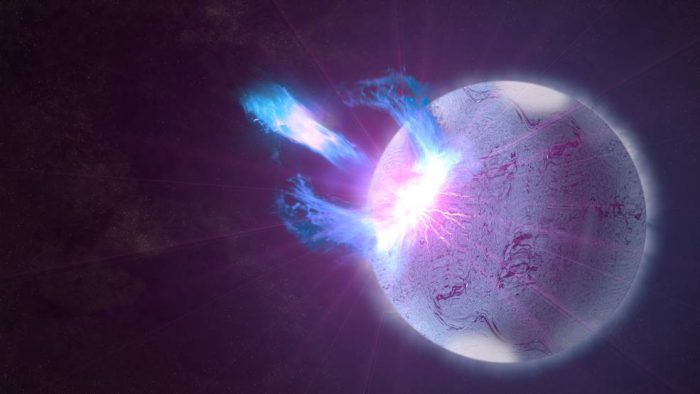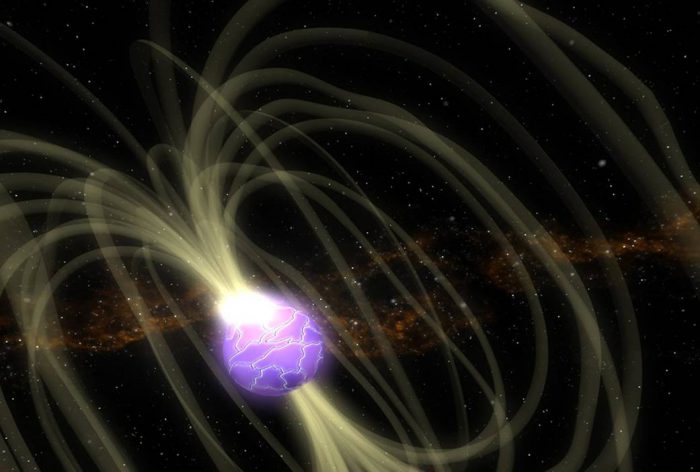Happy Monday! Welcome back to our Science Odyssey Contest event, where we're posting STEM articles from May 2 to May 17. To enter, you can find details at the bottom of this post.
QUIZ: A fast radio burst (FRB) is...
a) A car driving down the highway at 120 km/h with the windows down and the stereo cranked.
b) A kid wearing headphones on a roller coaster, listening to a basketball game.
c) A milliseconds-long, enormously powerful energy signal released from deep space.
If you answered a) or b), we agree that those both sound like fun right now. But a fast radio burst is actually c). Over before you can even blink, these intense events can release an energy equivalent to the power of 500 million Suns!
Why do they happen? Scientists aren't totally sure. But a recent event may finally help them crack the code.
You're tuned in to Milky Way radio

The signal was so powerful that BC's CHIME telescope wasn't even pointed directly at it and it still picked it up! (Z22/Wikimedia Commons)
Up until now, these events have only been observed coming from far outside our own galaxy, millions of light years away. This distance has added to the challenge of understanding their source.
But on April 28, the Canadian Hydrogen Intensity Mapping Experiment Fast Radio Burst Project (CHIME/FRB) in British Columbia captured a very curious, powerful signal — something that appeared to be an FRB coming from inside our own Milky Way.
But ...
What are radio waves, anyway?
NOT what picked up the fast radio burst. (Getty Embed)
When you hear the word 'radio', well... hearing is usually the key. Radio is something that we listen to — stations broadcast music and conversations on certain radio wave frequencies that we can then hear. You don't even need an internet connection. (Imagine that!)
Radio waves themselves are a type of electromagnetic radiation, belonging to the same spectrum as microwaves, infrared and ultraviolet light, X-rays, gamma rays, and, yep, visible light.
And while we're used to hearing things on radio waves, radio telescopes allow astronomers to see this radiation in the same way that we see visible light.
What is making this burst?

An artist's impression of a magnetar undergoing a starquake, the sort of activity that might be making these FRBs. (Getty Embed)
SGR 1935+2154 is a type of neutron star, called a magnetar, in our Milky Way. Neutron stars are basically star leftovers. The stuff that's left after a star dies.
Though not quite as dense as black holes, neutron stars are still very dense and have powerful gravity. And a magnetar is a neutron star with a very powerful magnetic field. The tension between this gravity and magnetic field creates huge starquakes and flares. And, some scientists believe, FRBs.
Recap!
Okay, so basically...
- Fast radio bursts are huge sources of energy that are mysterious
- Magnetars have long been thought to be a source of fast radio bursts
- A magnetar in the Milky Way called SGR 1935+2154 was caught by a radio telescope emitting what looks like an FRB
- And...
Well, scientists are still investigating. According to a report by ScienceAlert, astronomers are excited about this possible link between magnetars and FRBs. But they need to investigate more to know whether or not this link is absolutely true.
Whatever the result, it's a reminder of the incredible power — and mystery — that science is always trying to understand within our vast universe. Stay tuned!
Contest alert
Don't miss our Science Odyssey Contest. Click HERE TO ENTER.

 Magnetars are dense, dead stars whose powerful magnetic fields could be responsible for fast radio bursts. (NASA)
Magnetars are dense, dead stars whose powerful magnetic fields could be responsible for fast radio bursts. (NASA)









